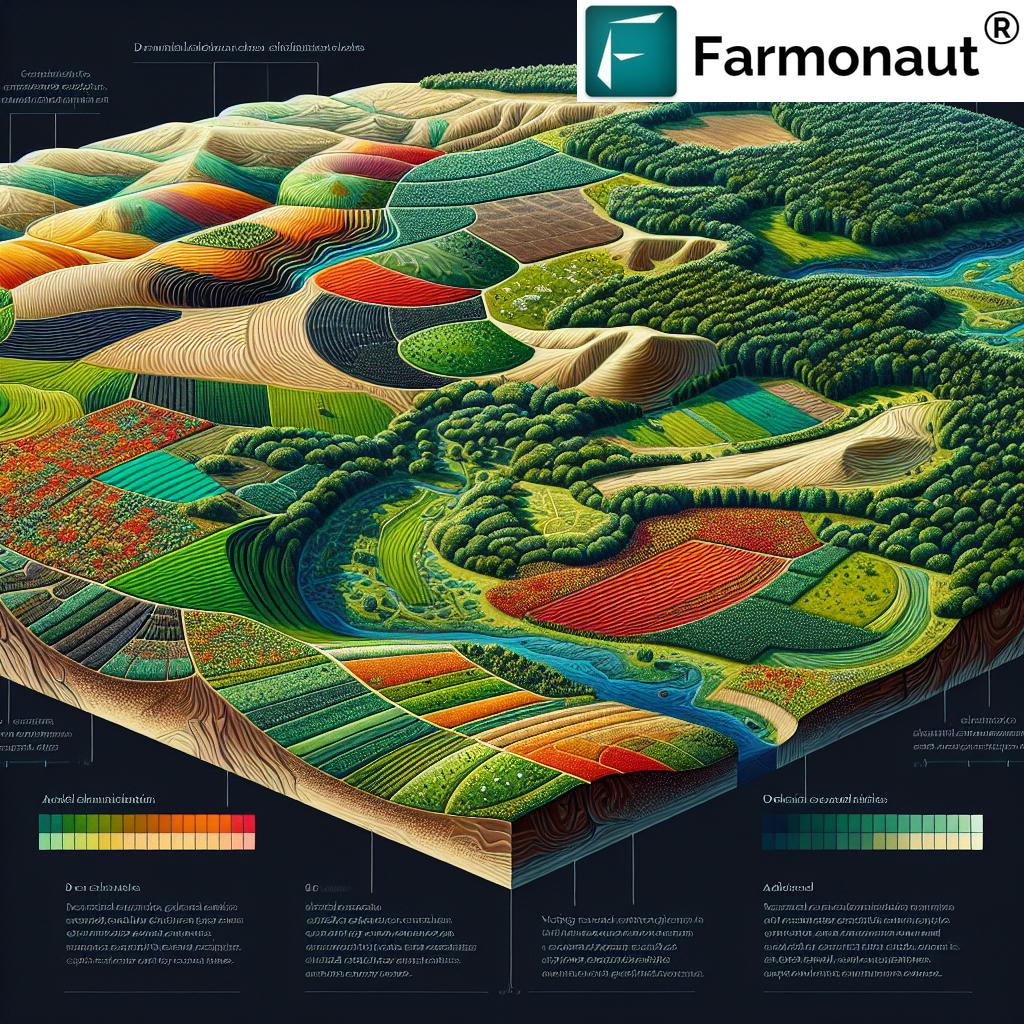Robotic Assembly Integrators: Agriculture Equipment Comparison (2025 Update)
“Over 60% of new agricultural assembly lines now integrate robotic automation systems for enhanced precision manufacturing.”
“In 2023, over 35 universities launched specialized programs in robotic assembly integrators for agri-equipment manufacturing.”
Table of Contents
- Industry Transformation: Robotic Assembly and Agricultural Equipment
- Comparison of Robotic Assembly Integrators with Experience in Agriculture Equipment
- Feature Comparison Table: Leading Robotic Assembly Integrators (2025)
- Comparing Robotic Automation Providers for Agricultural Equipment Production
- Are There Semester Schools with Integrated Farm, Forest, and Classroom Experiences?
- Future Trends in Agricultural Robotic Assembly and Workforce Development
- Where Does Farmonaut Fit in the Future of Agricultural Technology?
- Frequently Asked Questions
- Conclusion: The Road Ahead for Agricultural Equipment Manufacturing
Industry Transformation: Robotic Assembly and Agricultural Equipment
In recent years, the agricultural equipment manufacturing industry has experienced a significant transformation. Automation is no longer a distant vision; it is a current reality, rapidly expanding as digital technologies and precision farming practices drive demand for smarter, more efficient production lines. Increasing labor challenges, a growing need for cost containment, and stricter global standards are compelling manufacturers of tractors, harvesters, irrigation systems, and specialized components to adopt advanced robotic assembly systems.
Today’s leading robotic automation integrators are at the core of this transformation: they specialize in automating complex processes such as welding, painting, material handling, and component assembly for robust, large-scale agricultural equipment. The integration of AI, vision-based quality assurance, and Industrial IoT connectivity is further enhancing efficiency, reliability, and standards compliance.
An overview of the comparison of robotic assembly integrators with experience in agriculture equipment will help understand how this transformative shift supports modern agriculture as we move toward 2025 and beyond.
Comparison of Robotic Assembly Integrators with Experience in Agriculture Equipment
When comparing robotic assembly integrators with experience in agriculture equipment, four key players are at the forefront:
- FANUC
- ABB
- KUKA
- Yaskawa Motoman
FANUC: Flexible Automation for Reliable Production
FANUC is renowned in the industry for its flexible automation solutions and proven experience in both heavy-duty assembly and precision tasks crucial to modern agricultural equipment manufacturing. Their robots are known for:
- Sensor-based alignment—ideal for assembling complex combine harvesters.
- Integration with IoT-enabled factory floors for increasing production agility.
- Excellent reliability and global support network.
FANUC robots excel in automating welding, painting, and component assembly, making them essential for agricultural manufacturers seeking scalable automated production lines.
ABB: Modular Robotic Cells and Collaborative Assembly (“Cobots”)
ABB stands out for its modular robotic cells that can be customized for different stages of equipment assembly. Their key features include:
- Collaborative robots (cobots)—enabling robots and humans to work together safely, particularly valuable when handling large, irregular parts in agricultural machinery.
- Ease of integration with existing management and control systems.
- Optimized for both small and large payload capacities, allowing flexible task allocation on assembly lines.
KUKA: High Payload Capacity and Vision-Assisted Quality Assurance
KUKA emphasizes:
- Exceptional payload capacity and reach, suitable for handling the bulky components found in tractors, plows, and large gears or gearboxes.
- Advanced machine vision technologies for stringent quality assurance throughout the assembly process.
- Streamlined automation lines that adapt easily for new farming equipment or emerging technologies.
Yaskawa Motoman: Robust Arms for Welding, Painting, and Rugged Tasks
Yaskawa Motoman is noted for:
- Robust, heavy-duty robotic arms that withstand extensive use and harsh factory settings.
- Highly precise welding and painting functions for weather-resistant finishes—essential for equipment operating on outdoor farms or exposed forest conditions.
- Reliable after-sales support and ease of programming for flexible production needs.
Key Considerations for Manufacturers Choosing Robotic Integrators
When making a comparison between providers, manufacturers of agricultural equipment often evaluate:
- System scalability and ease of integration.
- Compatibility with existing manufacturing execution systems (MES).
- After-sales service support and warranty programs.
Additional considerations may include digital twin capabilities, AI-driven maintenance, and the availability of educational partnerships that connect the factory with the classroom and workforce training programs.
Feature Comparison Table: Leading Robotic Assembly Integrators (2025)
| Integrator Name | Robotic Solution Type | Key Features | Estimated Cost (USD) | Implementation Speed (weeks) | Automation Level (%) | Educational Partnership |
|---|---|---|---|---|---|---|
| FANUC | Automated tractor & harvester assembly, IoT integration | AI-enabled, IoT-connected, highly scalable, flexible tasks | $350,000 – $900,000 | 20–28 | 75–90 | No |
| ABB | Collaborative robotic (cobot) assembly cells | Modular, collaborative, safety features, MES compatible | $400,000 – $950,000 | 18–25 | 70–85 | Yes |
| KUKA | Heavy payload handling, vision-based QA, drone integration | Machine vision, high payload, modular lines, QA assurance | $370,000 – $850,000 | 22–30 | 78–92 | No |
| Yaskawa Motoman | Robust welding & painting, rugged assembly cells | Robust, weather-resistant, easy programming, high uptime | $340,000 – $880,000 | 18–26 | 75–88 | No |
| Siemens (Automation Provider) | Full factory automation, digital twin modeling | Digital twin, AI-driven planning, MES/ERP integration | $80,000 – $700,000 | 12–22 | 65–90 | Yes |
| Rockwell Automation | Connected enterprise; predictive maintenance software | Connected cells, predictive analysis, smart control | $90,000 – $750,000 | 14–24 | 68–88 | No |
| Oregon State University | Academic–integrated ag machinery labs | Hands-on curriculum, forest & farm integration | $40,000/semester | 16 (per term) | Varies | Yes |
| University of British Columbia | Forestry & ag robotics research program | Sustainability focus, classroom + fieldwork blend | $42,000/semester | 16 (per term) | Varies | Yes |
Comparing Robotic Automation Providers for Agricultural Equipment Production
A comparison of robotic automation providers for agricultural equipment production would be incomplete without including the software and control systems that tie together robotic integrators with the wider factory environment. As digital technologies mature, providers such as Siemens and Rockwell Automation have become central to automation in agriculture.
Siemens: Digital Twin, AI, and Complete Factory Integration
Siemens offers a versatile suite of software that introduces real-time simulation (digital twin) of every assembly step for agricultural equipment. This enables precise virtual modeling and fault detection, supporting:
- Reduced costs and downtime through predictive analytics.
- Real-time alignment between robotic assembly systems and enterprise resource planning (ERP).
- Enhanced traceability (see Farmonaut’s product traceability platform for satellite-enabled supply chains).
Rockwell Automation: Connected Enterprises and Predictive Maintenance
Rockwell Automation delivers comprehensive solutions with a focus on:
- Seamless communication between robotic cells, conveyor systems, and quality monitoring stations.
- Predictive maintenance, improving overall factory uptime.
- Scalable digital control systems adaptable to a range of agricultural machinery production needs.
In sum, together with integrators like FANUC, ABB, KUKA, and Yaskawa Motoman, providers like Siemens and Rockwell Automation enhance factory automation to meet the rigorous demands of current and future agricultural standards.
For seamless integration with digital platforms and supply chains, robust API connectivity is essential. Explore Farmonaut’s API for integrating satellite-driven agri-data, or delve into the developer documentation.
Are There Semester Schools with Integrated Farm, Forest, and Classroom Experiences?
This is a key search intent: “are there semester schools with integrated farm, forest, and classroom experiences?”. Today, YES: a new generation of educational programs and universities is engineering the workforce of the future by integrating agricultural practice, forestry management, and classroom theory.
- Oregon State University (USA): Their College of Agricultural Sciences and Forestry programs blend in-field work with robotic equipment exposure, digital monitoring, and collaborative innovation. Students get direct experience with operational farms and forests.
- University of British Columbia (Canada): The Faculty of Forestry offers leading-edge courses combining hands-on forest/agricultural robotics, sustainability, and classroom learning. Emphasis is on sustainable practices and technologies for next-gen equipment design.
Across the globe, more semester schools and universities recognize that the synergy of farm, forest, and classroom experiences is critical for nurturing the workforce that will lead the coming transformation in agricultural equipment production and robotic assembly.
Why Are Such Integrated Programs Essential?
- Hands-on Learning: Students gain direct experience with robotics, IoT, and digital twins on real farms and in forests.
- Technology Transfer: Classroom theory—from engineering control systems to sustainability—is applied in practical settings, building problem-solving skills for future manufacturing needs.
- Workforce Readiness: As precision farming and automation expand, there is high industry demand for graduates able to manage both the ecological and technical sides of agriculture and forestry.
If your goal is to build a sustainable, innovation-driven agricultural equipment factory, collaborating with universities or encouraging staff upskilling through semester programs delivers proven return on investment.
- For large-scale farm management and remote workforce training, consider Farmonaut’s Large Scale Farm Management Tool, which fuses satellite monitoring with integrated advisory systems—empowering farm leaders and educators to make data-driven decisions.
- For forestry, plantation, and agri-advisory applications, try Farmonaut’s Crop Plantation and Forest Advisory platform for sustainable planning and real-time field data.
Future Trends in Agricultural Robotic Assembly and Workforce Development
As we move toward 2025 and beyond, agricultural equipment manufacturing is set for rapid evolution. Emerging trends include:
- Widespread adoption of collaborative robots (“cobots”) for both small and large-scale production lines.
- Integration of digital twins and AI-driven maintenance for predictive and prescriptive analytics—reducing downtime and increasing equipment uptime.
- Data-driven traceability and blockchain connect all stages of equipment and component manufacturing. (Explore Farmonaut’s traceability product for supply chain transparency.)
- Smart sensors, vision-based quality assurance, and real-time IoT connectivity reconfiguring factory floors for agile responsiveness.
- Expanded semester schools and specialized university programs producing a new, highly skilled workforce equipped to support advanced automation and sustainability goals in farming technology.
These transformative shifts ensure agricultural equipment manufacturers will maintain global competitiveness, meet rising standards, and help customers (farmers, forestry operators, agri-corporations) achieve cost savings while enhancing efficiency.
- For fleet and resource management of your agricultural and forestry machinery, Farmonaut provides AI-powered fleet management solutions—delivering real-time tracking, usage optimization, and operational cost reduction.
- Explore sustainable carbon footprinting solutions for your factory or field with Farmonaut’s Carbon Footprinting Tool, which quantifies emissions and guides carbon reduction strategies.
- For crop insurance or loan verification in roboticized farm environments, see Farmonaut’s Crop Loan & Insurance Service—leveraging satellite-based data for rapid, fraud-resistant validation.
Farmonaut Subscription Options
Whether you’re a farmer, an equipment manufacturer, or an agri-business, Farmonaut’s subscription services deliver scalable, cost-effective tools for satellite-based monitoring, fleet and resource management, and blockchain-driven traceability. Accessible on web and mobile, our solutions empower teams to track, verify, and optimize operations with zero hardware investment.
Where Does Farmonaut Fit in the Future of Agricultural Technology?
While Farmonaut does not manufacture robotic assembly systems or equipment, we empower the broader industry with cutting-edge satellite and digital solutions:
- Satellite-Based Monitoring: Offering real-time, multispectral insights for crop health, soil conditions, and asset status to support informed resource management.
- Jeevn AI Advisory: Delivering AI-driven recommendations and strategies to users at all scales—aiding in production planning, hazard reduction, and sustainable output.
- Blockchain-Based Traceability: Facilitating transparent tracking of agri-equipment, reducing fraud, and enabling secure, data-backed lending or insurance across the value chain.
- Fleet & Resource Management: Helping ag businesses and manufacturers optimize machinery usage and ensure compliance while reducing operational costs.
- Environmental Monitoring: Providing actionable carbon footprint data, supporting both sustainable manufacturing and field operations.
Farmonaut’s value proposition: Making satellite, AI, and blockchain-driven solutions affordable, scalable, and accessible for anyone seeking to thrive in data-driven agriculture and equipment manufacturing.
Frequently Asked Questions: Robotic Assembly Integrators in Agricultural Equipment
What are robotic assembly integrators in agricultural equipment manufacturing?
Robotic assembly integrators are technology companies that design, deploy, and maintain automated robotic systems for assembling, welding, painting, and inspecting agricultural equipment such as tractors, harvesters, and irrigation tools. These integrators specialize in tailoring automation lines to meet the rugged, large-scale demands of agricultural machinery production.
How do I compare robotic automation providers for agricultural equipment production?
Comparison involves evaluating integrators and software providers by criteria such as system scalability, ease of programming, integration with manufacturing execution systems, after-sales support, cost, automation level (%), and unique features (e.g., AI, digital twin, vision-based quality assurance). See the Feature Comparison Table above for a direct overview.
Are there semester schools with integrated farm, forest, and classroom experiences?
Yes. Leading universities like Oregon State University and the University of British Columbia offer semester-based programs that combine fieldwork on farms and forests with in-classroom learning around sustainability, robotics, and digital technologies—preparing students for the evolving workforce in agriculture and forestry.
What role does Farmonaut play in robotic assembly or agri-equipment manufacturing?
Farmonaut does not manufacture machinery or robotic systems. Instead, we offer satellite-based monitoring, AI-driven advisory, blockchain traceability, and fleet/resource management solutions—helping users of any size optimize agriculture, mining, and infrastructure operations digitally.
Conclusion: The Road Ahead for Agricultural Equipment Manufacturing
By 2025, robotic assembly integrators will be indispensable to agricultural equipment manufacturing. Leading providers—FANUC, ABB, KUKA, and Yaskawa Motoman—enable scalable, collaborative, and precise automation tailored to the sector’s unique demands. Automation providers like Siemens and Rockwell Automation layer on advanced digital controls and predictive analytics.
Industrial transformation isn’t just about technology: the rise of semester schools and university programs integrating farm, forest, and classroom experiences is essential to nurture the workforce needed for the future of agri-equipment production. Companies and training institutions that invest in workforce upskilling, data-driven process optimization, and real-time remote monitoring (such as satellite-based solutions from Farmonaut) will maintain a competitive edge.
In sum, as farms, forests, and equipment factories expand, evolve toward precision and sustainability, and embrace automation, choosing the right balance of robotic assembly integrators, automation providers, and educational programs is the key to success in 2025 and beyond.
Enhance your digital agri-equipment value chain—explore leading solutions for satellite monitoring, traceability, sustainability, and digital farm management:
- Farmonaut’s Carbon Footprinting
- Farmonaut Product Traceability
- Farmonaut Fleet Management
- Farmonaut Crop Loan & Insurance
- Farmonaut Large Scale Farm Management
Ready to participate in the next wave of agricultural technology?











